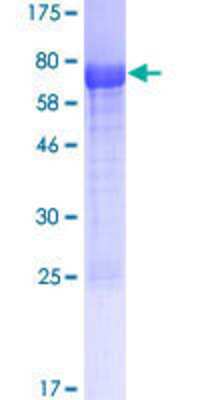NHERF-1 Products
EBP 50 [ERM (ezrin-radixin-moesin) binding phosphoprotein of 50 kDa] is a PDZ containing protein that is involved in the linkage of integral membrane proteins to the cytoskeleton. EBP50 contains two tandem PDZ domains followed by a carboxy-terminal sequence that binds to members of the ERM family of membrane-cytoskeleton adaptors. The PDZ domains within EBP50 bind to the carboxy termini of such target proteins as beta2 adrenergic receptor, platelet-derived growth factor receptor (PDGFR), and the cystic fibrosis conductance regulator (CFTR). The PDZ domains are also believed to be involved in the oligomerization of EBP 50 to form multiprotein complexes which helps to facilitate the formation of functional signalling complexes. EBP 50 has been shown to link integral membrane proteins to the cytoskeleton by binding to members of the ERM family of proteins, which bind to F-actin. Through these interactions, EBP 50 is implicated in the localization of interactive groups of proteins into subcellular domains and in the regulation of activity of those interacting proteins. Immunohistochemical studies have shown that EBP 50 is found exclusively at the apical membranes of epithelial cells.
Show More
34 results for "NHERF-1" in Products
34 results for "NHERF-1" in Products
NHERF-1 Products
EBP 50 [ERM (ezrin-radixin-moesin) binding phosphoprotein of 50 kDa] is a PDZ containing protein that is involved in the linkage of integral membrane proteins to the cytoskeleton. EBP50 contains two tandem PDZ domains followed by a carboxy-terminal sequence that binds to members of the ERM family of membrane-cytoskeleton adaptors. The PDZ domains within EBP50 bind to the carboxy termini of such target proteins as beta2 adrenergic receptor, platelet-derived growth factor receptor (PDGFR), and the cystic fibrosis conductance regulator (CFTR). The PDZ domains are also believed to be involved in the oligomerization of EBP 50 to form multiprotein complexes which helps to facilitate the formation of functional signalling complexes. EBP 50 has been shown to link integral membrane proteins to the cytoskeleton by binding to members of the ERM family of proteins, which bind to F-actin. Through these interactions, EBP 50 is implicated in the localization of interactive groups of proteins into subcellular domains and in the regulation of activity of those interacting proteins. Immunohistochemical studies have shown that EBP 50 is found exclusively at the apical membranes of epithelial cells.
Show More
Applications: IHC, WB, ICC/IF, IP
Reactivity:
Human,
Mouse,
Rat,
Canine
| Reactivity: | Human, Mouse, Rat, Canine |
| Details: | Rabbit IgG Polyclonal |
| Applications: | IHC, WB, ICC/IF, IP |
| Reactivity: | Human |
| Details: | Rabbit IgG Polyclonal |
| Applications: | IHC, WB, ICC/IF |
| Reactivity: | Human |
| Details: | Rabbit IgG Polyclonal |
| Applications: | IHC, WB |
Applications: IHC, WB, ELISA, Func
Reactivity:
Human
| Reactivity: | Human |
| Details: | Mouse IgG2a Kappa Monoclonal Clone #2B7 |
| Applications: | IHC, WB, ELISA, Func |
| Reactivity: | Human |
| Details: | Mouse IgG2B Monoclonal Clone #EBP-10 |
| Applications: | IHC, WB, IP |
| Applications: | WB, ELISA, MA, AP |
Applications: IHC, WB, IP
Reactivity:
Human,
Mouse
| Reactivity: | Human, Mouse |
| Details: | Rabbit IgG Polyclonal |
| Applications: | IHC, WB, IP |
| Applications: | WB |
| Reactivity: | Human |
| Details: | Rabbit IgG Polyclonal |
| Applications: | IHC, WB, IP |
| Reactivity: | Human |
| Details: | Mouse IgG2B Monoclonal Clone #EBP-10 |
| Applications: | IHC, WB, IP |
| Applications: | AC |
| Applications: | AC |
Applications: WB, ELISA
Reactivity:
Human,
Mouse,
Rat
| Reactivity: | Human, Mouse, Rat |
| Details: | Rabbit IgG Polyclonal |
| Applications: | WB, ELISA |
| Reactivity: | Human |
| Details: | Mouse IgG2B Monoclonal Clone #EBP-10 |
| Applications: | IHC, WB, IP |
| Reactivity: | Human |
| Details: | Mouse IgG2B Monoclonal Clone #EBP-10 |
| Applications: | IHC, WB, IP |
| Reactivity: | Human |
| Details: | Mouse IgG2B Monoclonal Clone #EBP-10 |
| Applications: | IHC, WB, IP |
| Reactivity: | Human |
| Details: | Mouse IgG2B Monoclonal Clone #EBP-10 |
| Applications: | IHC, WB, IP |
| Reactivity: | Human |
| Details: | Mouse IgG2B Monoclonal Clone #EBP-10 |
| Applications: | IHC, WB, IP |
| Reactivity: | Human |
| Details: | Mouse IgG2B Monoclonal Clone #EBP-10 |
| Applications: | IHC, WB, IP |
| Reactivity: | Human |
| Details: | Mouse IgG2B Monoclonal Clone #EBP-10 |
| Applications: | IHC, WB, IP |
| Reactivity: | Human |
| Details: | Mouse IgG2B Monoclonal Clone #EBP-10 |
| Applications: | IHC, WB, IP |
| Reactivity: | Human |
| Details: | Mouse IgG2B Monoclonal Clone #EBP-10 |
| Applications: | IHC, WB, IP |
| Reactivity: | Human |
| Details: | Mouse IgG2B Monoclonal Clone #EBP-10 |
| Applications: | IHC, WB, IP |
| Reactivity: | Human |
| Details: | Mouse IgG2B Monoclonal Clone #EBP-10 |
| Applications: | IHC, WB, IP |
| Reactivity: | Human |
| Details: | Mouse IgG2B Monoclonal Clone #EBP-10 |
| Applications: | IHC, WB, IP |

![Western Blot: NHERF-1 Antibody [NB300-536] Western Blot: NHERF-1 Antibody [NB300-536]](https://resources.bio-techne.com/images/products/NHERF-1-Antibody-Western-Blot-NB300-536-img0005.jpg)
![Western Blot: NHERF-1 Antibody [NBP1-84918] Western Blot: NHERF-1 Antibody [NBP1-84918]](https://resources.bio-techne.com/images/products/NHERF-1-Antibody-Western-Blot-NBP1-84918-img0023.jpg)
![Western Blot: NHERF-1 Antibody [NBP1-84919] Western Blot: NHERF-1 Antibody [NBP1-84919]](https://resources.bio-techne.com/images/products/NHERF-1-Antibody-Western-Blot-NBP1-84919-img0010.jpg)
![Immunohistochemistry-Paraffin: NHERF-1 Antibody (2B7) [H00009368-M02] Immunohistochemistry-Paraffin: NHERF-1 Antibody (2B7) [H00009368-M02]](https://resources.bio-techne.com/images/products/NHERF-1-Antibody-2B7-Immunohistochemistry-Paraffin-H00009368-M02-img0003.jpg)
![Western Blot: NHERF-1 Antibody (EBP-10) - BSA Free [NB500-488] NHERF-1 Antibody (EBP-10) - BSA Free Western Blot: NHERF-1 Antibody (EBP-10) - BSA Free [NB500-488]](https://resources.bio-techne.com/images/products/nb500-488_mouse-monoclonal-nherf-1-antibody-ebp-10-1312024169400.jpg)


![Western Blot: NHERF-1 Overexpression Lysate [NBL1-16198] Western Blot: NHERF-1 Overexpression Lysate [NBL1-16198]](https://resources.bio-techne.com/images/products/NHERF-1-Overexpression-Lysate-Adult-Normal-Western-Blot-NBL1-16198-img0002.jpg)
![Western Blot: NHERF-1 Antibody [NBP3-35065] - NHERF-1 Antibody](https://resources.bio-techne.com/images/products/nbp3-35065_rabbit-nherf-1-pab-912202415161873.jpg)